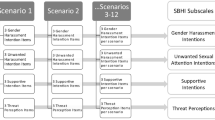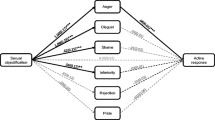Abstract
In this study, we used an interactive perspective to address the issue of responses to sexual harassment. We examined the effect of the consistency across time, consistency across types of advances, and assertiveness of a rejecting response on its perceived effectiveness. Participants were presented with scenarios that described responses to unwanted sexual attention and were required to rate the effectiveness of the responses for their clarity, content, and estimated effect on the future behavior of the perpetrator. The results show significant effects of consistency across time, consistency across types of advances, and assertiveness on perceived effectiveness of the response. As expected, an assertive response that was consistent across time and types of advances was perceived to be the most effective. This effect was found to be stronger for women than for men.
Similar content being viewed by others
REFERENCES
Afifi, W. A., & Lee, J. W. (2000). Balancing instrumental and identity goals in relationships: The role of request directness and request persistence in the selection of sexual resistance strategies. Communication Monographs, 67, 284–305.
Baird, C. L., Bensko, N. L., Bell, P. A., Viney, W., & Woody, W. D. (1995). Gender influence on perceptions of hostile environment sexual harassment. Psychological Reports, 77, 79–82.
Benson, D. J., & Thompson, G. E. (1982). Sexual harassment on a university campus: The confluence of authority relations, sexual interest, and gender stratification. Social Problems, 29, 236–251.
Berger, P., & Luckmann, T. (1966). The social construction of reality. New York: Anchor.
Brooks, L., & Perot, A. R. (1991). Reporting sexual harassment: Exploring a predictive model. Psychology of Women Quarterly, 15, 31–47.
Cochran, C. C., Frazier, P. A., & Olson, A. M. (1997). Predictors of responses to unwanted sexual attention. Psychology of Women Quarterly, 21, 207–226.
Corr, P. J., & Jackson, C. J. (2001). Dimensions of perceived sexual harassment: Effects of gender and status/liking of protagonist. Personality and Individual Differences, 30, 525–539.
De Judicibus, M., & McCabe, M. P. (2001). Blaming the target of sexual harassment: Impact of gender role, sexist attitudes, and work role. Sex Roles, 44, 401–417.
Firestone, J. M., & Harris, R. J. (2003). Perceptions of effectiveness of responses to sexual harassment in the US military, 1988 and 1995. Gender, Work and Organizations, 10, 42–64.
Fitzgerald, L. F., Gelfand, M. J., & Drasgow, F. (1995). Measuring sexual harassment: Theoretical and psychometric advances. Basic and Applied Social Psychology, 17, 425–445.
Fitzgerald, L. F., & Hesson-McInnis, M. (1989). The dimensions of sexual harassment: A structural analysis. Journal of Vocational Behavior, 35, 309–326.
Fitzgerald, L. F., & Ormered, A. J. (1991). Perceptions of sexual harassment: The influence of gender and academic context. Psychology of Women Quarterly, 15, 281–294.
Fitzgerald, L. F., & Shullman, S. L. (1993). Sexual harassment: A research analysis and agenda for the 1990s. Journal of Vocational Behavior, 42, 5–27.
Fitzgerald, L. F., Swan, S., & Fischer, K. (1995). Why didn't she just report him? The psychological and legal implications of women's responses to sexual harassment. Journal of Social Issues, 51, 117–138.
Gilbert, D. T., & Malone, P. S. (1995). The correspondence bias. Psychological Bulletin, 117, 21–38.
Gruber, J. E. (1989). How women handle sexual harassment: A literature review. Sociology and Social Research, 74, 3–9.
Gruber, J. E., & Smith, M. (1995). Women's responses to sexual harassment: A multivariate analysis. Basic and Applied Social Psychology, 17, 301–320.
Gutek, B. A. (1985). Sex and the workplace. San Francisco: Jossey-Boss.
Gutek, B. A., & Koss, M. P. (1993). Changed women and changed organizations: Consequences of and coping with sexual harassment. Journal of Vocational Behavior, 42, 28–48.
Henry, J., & Meltzoff, J. (1998). Perceptions of sexual harassment as a function of target's response type and observer's sex. Sex Roles, 39, 253–271.
Hunter, C., & McClelland, K. (1991). Honoring accounts for sexual harassment: A factorial survey analysis. Sex Roles, 24, 725–751.
Jensen, I., & Gutek, B. (1982). Attributions and assignment of responsibility for sexual harassment. Journal of Social Issues, 38, 121–136.
Jones, E. E., & Nisbett, R. E. (1987). The actor and the observer: Divergent perceptions of the causes of behavior. In D. E. Kanouse & E. E. Jones (Eds.), Attribution: Perceiving the causes of behavior (pp. 79–94). Hillsdale, NJ: Erlbaum.
Jones, T. S., & Remland, M. S. (1992). Sources of variability in perceptions of and responses to sexual harassment. Sex Roles, 27, 121–142.
Jones,T. S., Remland, M. S., & Brunner, C. C. (1987). Effects of employment relationship, response of recipient, and sex of rater on perceptions of sexual harassment. Perceptual and Motor Skills, 65, 55–63.
Kelley, H. H. (1972). Causal schemata and the attribution process. In E. E. Jones, D. E. Kanouse, H. H. Kelley, R. E. Nisbett, S. Valins, & B. Weiner (Eds.), Attribution: Perceiving the causes of behavior (pp. 151–174). Morristown, NJ: General Learning Press.
Kenig, S., & Ryan, J. (1986). Sex differences in levels of tolerance and attribution of blame for sexual harassment on a university campus. Sex Roles, 15, 535–549.
Knapp, D. E., Faley, R. H., Ekeberg, S. E., & Dubois, L. Z. (1997). Determinants of target responses to sexual harassment: A conceptual framework. Academic of Management Review, 22, 687–729.
Krolokke, C. (1998). Women professors' assertive-empathic and non-assertive communication in sexual harassment situations. Women's Studies in Communication, 21, 91–100.
Magley, V. J. (2002). Coping with sexual harassment: Re-conceptualizing women's resistance. Journal of Personality and Social Psychology, 83, 930–946.
Malamut, A. B., & Offerman, L. R. (2001). Coping with sexual harassment: Personal, environmental, and cognitive determinants. Journal of Applied Psychology, 6, 1152–1166.
Osman, S. (2004). Victim resistance: Theory and data on understanding perceptions of sexual harassment. Sex Roles, 50, 267–275.
Peirce, E. R., Rosen, B., & Hiller, T. B., (1997). Breaking the silence: Creating user-friendly sexual harassment policies. Employee Responsibilities and Rights Journal, 10, 225–242.
Peterson, D. R. (1988). Interpersonal goal conflict. In L. A. Pervin (Ed.), Goal concepts in personality and social psychology (pp. 327–363). Hillsdale, NJ: Erlbaum.
Rospenda, K. M., Richman, J. A., & Nawyn, S. J. (1998). Doing power: The confluence of gender, race, and class in contrapower sexual harassment. Gender and Society, 12, 40–60.
Ross, L. (1977). The intuitive scientist and his shortcomings. In L. Berkovitz (Ed.), Advances in experimental social psychology (Vol. 10, pp. 174–221). New York: Academic Press.
Rubin, L. J., & Borgers, S. B. (1990). Sexual harassment in universities during the 1980s. Sex Roles, 23, 397–411.
Rudman, L. A., Borgida, E., & Robertson, B. A. (1995). Suffering in silence: Procedural justice versus gender socialization issues in university sexual harassment grievance procedures. Basic and Applied Social Psychology, 34, 519–541.
Sbraga, T. P., & O'Donohue, W. (2000). Sexual harassment. Annual Review of Sex Research, 11, 258–286.
Sigal, J., Braden-Maguire, J., Patt, I., Goodrich, C., & Perrino, C. S. (2003). Effects of type of coping response, setting, and social context on reactions to sexual harassment. Sex Roles, 48, 157–166.
Simon, W., & Gagnon, J. (1986). Sexual scripts: Permanence and change. Archives of Sexual Behavior, 15, 117–131.
Smirles, K. E. (2004). Attributions of responsibility in cases of sexual harassment: The person and the situation. Journal of Applied Social Psychology, 34, 342–365.
Stockdale, M. S. (1998). The direct and moderating influences of sexual harassment pervasiveness, coping strategies, and gender on work related outcomes. Psychology of Women Quarterly, 22, 521–535.
Tangri, S. S., Burt, M. R., & Johnson, L. B. (1982). Sexual harassment at work: Three explanatory models. Journal of Social Issues, 38, 33–54.
Woodzicka, J. A., & LaFrance, M. (2001). Real versus imagined gender harassment. Journal of Social Issues, 57, 15–30.
York, K. M. (1989). Defining sexual harassment in workplaces: A policy-capturing approach. Academy of Management Journal, 32, 830–850.
Author information
Authors and Affiliations
Corresponding author
Rights and permissions
About this article
Cite this article
Yagil, D., Karnieli-Miller, O., Eisikovits, Z. et al. Is that a “No”? The Interpretation of Responses to Unwanted Sexual Attention. Sex Roles 54, 251–260 (2006). https://doi.org/10.1007/s11199-006-9342-2
Issue Date:
DOI: https://doi.org/10.1007/s11199-006-9342-2




